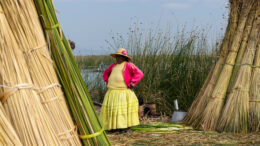“We call it Puno York,” says Augusto Parodi, a local architect, as the bus rolls down the hill. There’s no irony in his voice, yet the name is obviously a joke. Despite being one of the largest cities in Peru, Puno only counts around 140,000 residents, and — in Parodi’s words — “is but a speck of dust” when compared to the Big Apple.
Dust seems an appropriate word. Since the fall of 2022, the region has suffered from a drought that turned the nearby mountains into a barren wasteland and covered the crooked streets and slanted houses in a reddish-brown grime.
Like other towns peppering the Peruvian highlands, Puno is no stranger to dry spells. But this one has proved to be one of the worst in recorded history, continuing into 2023 and — thanks to the global climate phenomenon known as El Niño — even early 2024, affecting agriculture, fishing, livestock, tourism, and just about every other industry.
Some of the worst effects were felt by the Uros, an Indigenous people living on Lake Titicaca, the 3,200-square-mile body of water that stretches from Puno to the outskirts of La Paz, Bolivia. The lake — the biggest in the Andes, and the highest navigable water body in the world — shrank significantly during the past two years, with the water receding up to 1.25 miles in some areas.
“We are going through a crisis,” Nelson Coila Lujando, a member of the Uros community, told me back in February. As per custom, he and his family live on manmade floating islands in the middle of the lake. The islands, lashed together by water-resistant totora roots and reeds, have been the Uros’ refuge for centuries and allowed them to move their homes to fertile fishing grounds and avoid threats.
You can’t move a floating island to avoid droughts this bad.
The Uros, who call themselves the Guardians of Titicaca, subsist on fish, waterbirds, and the sale of handcrafted souvenirs. Their traditional existence can be traced back to the dawn of the Inca Empire, when the Uros’ are said to have moved onto the lake to escape subjugation on land. Their history and culture are now at risk of being wiped out by climate change.
“The reeds that we use to build our islands aren’t growing,” Lujando says. “The lake is drying up and we can’t move. The birds — they have gone in search of water, leaving behind only a few eggs. The fish are also gone.”
Surviving the Drought
The 2022-2023 drought rendered Titicaca almost unrecognizable. In November 2023, Flores Sancho, director of the National Meteorology and Hydrology Service of Peru (Senamhi) announced that the amount of rainfall in the region had fallen by 49%, causing the water flowing through the tributaries that feed the lake to drop by almost 80%. At its peak Titicaca’s overall water level fell by over 19 inches, with 120 metric tons evaporating per year.
As the water retreated, Puno’s bay quickly ran dry, leaving dozens of fishing and touring boats stuck in the waste-filled dirt.
In November 2023, reporters from the French newspaper Le Monde managed to make it to the floating home of Maruja Mamani, where she spoke of the growing shortage of totora reeds, a species of bulrush sage the Uros use to build their 9-feet-thick base of their islands.
“Our islands need a lot of maintenance,” she told the paper. “Every two weeks we have to add green reeds and every three months have to completely rebuild our houses.” According to Le Monde, more than 90% of the lake’s reeds had dried out, making them unusable. To harvest the remainder of fresh plants, the Uros had to sail to the far end of the lake, a journey that — on a good day — takes almost three hours, placing them far away from the resources they need.
View this post on Instagram
Totora forms the basis of Titicaca’s ecosystem. As the reeds disappeared, so did the animals that depend on them for food and egg laying: the native carachi, a small, yellowish fish of the Cyprinodontidae family; trout, introduced to the lake in the 20th century; the Puneño duck (Spatula puna), with its black-spotted head and green-streaked wings; and the fuzzy-haired grebe known as the Zambullidor del Titicaca (Rollandia microptera), currently endangered.
Unable to grow crops on the open water, the Uros have historically lived as hunter-gatherers, cooking their catch or trading it on the Puno market. When drought struck and there was nothing to hunt or barter, the islanders with money were forced to eat through their savings, provided they were able to make it to Puno, while those without went hungry.
The situation on the mainland wasn’t much better, though. The drought ruined harvests, shortening the supply of quinoa and potatoes, as well as the oats used to feed livestock. In neighboring Bolivia, the government attempted to irrigate crops by pumping water from the lake. Not only did this further contribute to Titicaca’s depletion, farmers say the lake water — saltier than rainfall — ended up burning many of their seeds.
In normal circumstances, Uros members travel to the city almost every day, buying food at the market, taking their children to high school and university, and picking up tourists for guided tours of the islands. Without access to Puno, the islanders were isolated from their education, food supply, and main source of income.
In late 2023 conditions got so dire that some 1,500 Uros — approximately 75% of the entire community — banded together to dig a canal that would reconnect their islands to the dried up Puno bay. They raised money to rent construction equipment, but, according to Bogotá-based photojournalist Yader Guzman, the Peruvian government forced them to quit before the project could finish. Guzman documented the aftermath of their Sisyphean endeavor: an abandoned CAT excavation machine strapped to a barge, drifting between the dried-up reeds.
View this post on Instagram
Beyond El Niño
This isn’t the first time El Niño has wreaked havoc in the Puno region.
“Really big El Niño events can cause dry conditions on the Altiplano,” says Paul Baker, a professor of earth and climate sciences at Duke University who studied the geological history of Lake Titicaca, referring to the Andean plateau that covers southern Peru. “In 1982-1983, a huge Eastern Pacific El Niño brought about terrible conditions at the lake. There was no rain in December, January and February. No crops survived, livestock were devastated, and people from the highlands were forced to migrate.”
Migrations also took place during El Niño cycles in 1991 and 1943, when Titicaca’s water levels fell by more than 8 feet — the largest drop in recorded history.
As global warming increases, scientists fear future El Niño cycles — which occur roughly every three to five years and are connected to shifting trade winds — are only going to get worse.
Asked about the severity of this particular cycle, Jhan Carlo Espinoza Villar, director at the French National Research Institute for Sustainable Development, points the finger at deforestation in the Amazon rainforest.
The 2022-2023 El Niño, he says, “was characterized by an exceptional lack of moisture from the Amazon basin to the Altiplano.” Currently the Amazon is shrinking at a pace of roughly 4,466 square miles per year. If deforestation continues, as it did during the presidency of Jair Bolsonaro, the Andean highlands can expect longer, harsher droughts.
Villar’s remark about the effects of Amazon deforestation on the Altiplano highlights an important but occasionally overlooked fact: While El Niño worsened the drought around Titicaca, the drought’s underlying cause is climate change. The truth, says Flores, is that rainy seasons in the Peruvian Andes have been getting shorter since 2013. Titicaca’s fish populations have also been in steady decline, falling 90% in just 30 years, a development attributed in part to overfishing and demographic pressure, but also to pollution and climate breakdown.
While the current El Niño cycle is predicted to fizzle out in June, the drought terrorizing Lake Titicaca shows no sign of stopping. According to a report shared with the Peruvian newspaper La República, scientists expect the summer of 2024 to bring above-normal rainfall in the northwestern part of the country — possibly creating dangerous flooding — but below-average precipitation in the south, where Puno and Titicaca are located.
While Stéphane Guedron, who studies paleoenvironmental geochemistry Université Grenoble Alpes in France, told The Revelator that 2024 has thus far been “a crazy rainy one, even though it was expected to stay dry,” the Uros would beg to differ.
“We don’t know if it’s summer or winter,” Nelson says, watching passing storm clouds with the same level of anticipation and dread as one would watch the little white ball on a roulette table. “The reeds have not grown back. This is a very serious problem, as we won’t be able to maintain our houses and make handicrafts. Our future, the future of the Guardians of Lake Titicaca, is at risk.”
If the rate of global warming can’t be slowed, the communities living in and around Titicaca will be reliant on federal aid to make it through future droughts. While the Bolivian government allocated $17 million last October to purchase and distribute drinking water, people living on the Peruvian side have yet to receive such help.
There, Puno’s majority Aymara population — another Peruvian Indigenous group, larger than the Uros — hired a shaman to make an offering to Pachamama, the Mother Earth deity worshiped by the Incas.
A sacrifice was made, but when the rain finally came, it was too late and too little.
Get more from The Revelator. Subscribe to our newsletter.

Previously in The Revelator:
Páramos at Risk: The Interconnected Threats to a Biodiversity Hotspot



